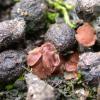
19-08-2011 09:29
 Alex Akulov
Alex Akulov
Dear Friends Today I had the opportunity to see a

17-08-2011 22:51
 Alex Akulov
Alex Akulov
Dear Friends During my recent trip to the Carpath

14-08-2011 17:47
 Alex Akulov
Alex Akulov
Dear FriendsYesterday ended my second in this year

12-08-2011 14:54
roman vargas albertoHello, Do you know if the Peziza arvernensis has i
Pseudombrophila bulbifera
DirkW,
21-08-2011 14:37
 salut a tous,
salut a tous,in case of an article about pseudombrophila bulbifera, i'm in search of informations concerning ecology and distribution. has anybody made collections of this rare taxa, one of only two pseudombrophila-species with globose spores?
if someone has the diagnose of boudiers ascophanus dentatus (Bull. Soc. Mycol. France 13) i would be very thankful!!
Cordialement
Dirk
Peter Welt,
21-08-2011 15:39

Re : Pseudombrophila bulbifera
Hallo Dirk,
schöner Fund. Hast du die Pseudombrophila Arbeit von van Brummelen?
Die Arbeit von Boudier findest du hier:
Du zweifelst wohl an deiner Bestimmung? Die beiden Arten unterscheiden
sich nur durch die Sporengröße (über 10 oder unter 10 µm für denutata) und Ps. bulbifera
soll ein Sclerotium habe, was ich bei meinen Fund aber auch nicht so recht
finden konnte.
Gruß Peter
Nicolas VAN VOOREN,
21-08-2011 15:46

Re : Pseudombrophila bulbifera
About P.bulbifera, you can read this paper:
Moyne G. 2008. Pseudombrophila bulbifera (E.J. Durand) Brumm. Un champignon coprophile peu commun. Bulletin mycologique et botanique Dauphiné-Savoie, 191, p. 45-49.
Moyne G. 2008. Pseudombrophila bulbifera (E.J. Durand) Brumm. Un champignon coprophile peu commun. Bulletin mycologique et botanique Dauphiné-Savoie, 191, p. 45-49.
Peter Welt,
21-08-2011 15:56

Re : Pseudombrophila bulbifera
Hi Rene,
On article about coprophious mushrooms I'm always interested. One can not unfortunately have any magazines. The love of money is not enough there. ;-)
Best regards Peter
PS: Mistake on my part. I meant Nicolas. Nobody is perfect. ;-)
Rene your proposal is not bad either, which has everything you as a PDF, you can take in the computer.
Thank you Peter
On article about coprophious mushrooms I'm always interested. One can not unfortunately have any magazines. The love of money is not enough there. ;-)
Best regards Peter
PS: Mistake on my part. I meant Nicolas. Nobody is perfect. ;-)
Rene your proposal is not bad either, which has everything you as a PDF, you can take in the computer.
Thank you Peter
René Dougoud,
21-08-2011 16:08
Re : Pseudombrophila bulbifera
Cher Collègue,
Je vous adresse, en privé, à cause du poids, un scan de la publication de Brummelen, répondant à votre demande.
Je signale toutefois qu'il y a, dans ce genre, et contrairement à ce que vous avez indiqué, deux espèces qui possèdent des ascospores sphériques. la deuxième étant P. dentata, sur excréments de lapin !!
René
Je vous adresse, en privé, à cause du poids, un scan de la publication de Brummelen, répondant à votre demande.
Je signale toutefois qu'il y a, dans ce genre, et contrairement à ce que vous avez indiqué, deux espèces qui possèdent des ascospores sphériques. la deuxième étant P. dentata, sur excréments de lapin !!
René


